Sub Categories
- Agricultural Extension and other Fig Publications
- An Overall Experience!
These are all features created by Fig Database. Some have copied it, some are still trying to copy it. Fact of the matter is that they can keep trying but they can't ever duplicate the original. Here is where it all started.
- A modern and user friendly design for your overall experience.
- Faster load time throughout and responsive so you can use it on any mobile device.
- An extensive collection of fig varieties and images
- A broad set of search criterias to helps you find the varieties you really want fast and smoothly.
- Mapping to show you where fig varieties are grown, and member proximity to help you find varieties they grow and may be suitable for your area, climate or zone.
- The ability to create your own custom variety lists. You have complete control of what you add from your lists!
- Variety user notes (for the "Owned" list) enables you to save your own personal notes on each variety.
- A catalog for each of the varieties you own to keep important information in one safe location. (shareable, printable and editable at any time)
- A first on Fig Database feature, the new "Fig Database QR System". A way for you to now print out any QR code from any variety in the database and use it to label your plants, share with your friends to direct them to a full informational page, and upload information to any variety with just a scan away.
- The original member reviews and star ratings of fig varieties that provide the easiest and most helpful way to share your fig variety experiences with everyone in the community.
- Variety detail information submission form for you to add missing information to help out the rest of the community.
- Description submission form for you to share your experience on varieties. What better way to show the world what you think of a certain variety!
- Photograph submission option for you to share your fig images with the rest of the community.
- Variety suggestion submission form. If you found a fig in California and would like to add it to the database, you can submit it for review here.
- An updated private messaging system that allows you to stay in touch with friends, do trades and overall exchange information with other fig collectors like you.
- Following system - The ability to follow your friends or favorite fig collectors (beta - in the works to make it functional with notification of lates additions, contributions, added pictures etc.).
- A new point system we call "Accomplishments" (earn points for submitting information, descriptions, images and leaving other members feedback).
- A custom badge system (created by Fig Database) to praise you, the contributor. The more points you earn, the higher the badge it is you get.
- A personal "About Me" form just for your profile to let others looking into you know a little bit about yourself.
- A dedicated Facebook page to keep you up to date on the latest news and updates.
- Best and most important is, the team! Without these guys, it just wouldn't be possible. Be sure you thank them for being phenomenal members of the fig community.
And much more coming in the near future!!!
- Can I buy fig trees from outside the US?
Yes, you can buy fig trees from outside the US, but there are several important considerations and restrictions you need to be aware of:
Regulations and Restrictions:
-
Import Permits:
-
USDA Regulations: Importing plants, including fig trees, into the United States is regulated by the USDA (United States Department of Agriculture) to prevent the introduction of pests and diseases.
-
Permit Requirement: Depending on the country of origin, you may need an import permit to bring fig trees into the US. It's essential to check the USDA's Animal and Plant Health Inspection Service (APHIS) website for specific requirements.
-
-
Phytosanitary Certificate:
-
Health Certification: The exporting country must provide a phytosanitary certificate, which certifies that the plants are free from pests and diseases. This certificate is usually issued by the exporting country's agricultural authority.
-
-
Inspection:
-
Customs Inspection: Upon arrival in the US, fig trees will be inspected by customs officials to ensure they comply with import regulations and are free from pests and diseases.
-
Other than that:
-
NO! Importing fig trees anywhere from outside of the US comes with the possibility of introducing invasive pests or noxious weeds into the environment and is illegal.
-
- Can I grow fig trees in pots?
Yes, you can grow fig trees in pots, and they can thrive quite well under the right conditions. Growing fig trees in containers is especially beneficial if you have limited garden space, poor soil quality, or live in a region with cold winters, as pots allow you to move the trees indoors during colder months.
Potted fig trees are also easier to manage in terms of watering, soil quality, and pruning, making them an excellent option for both novice and experienced gardeners. By choosing an appropriately sized container with good drainage, using high-quality potting soil, and providing adequate sunlight and care, your potted fig tree can produce delicious fruit and add a touch of greenery to your space.
- Do fig trees prefer the sun or the shade?
Almost everyone will tell you that they require full sun. That is because most people telling you that don't know South Florida or Texas sun. The answer is "most of the time", depending where you live. Here in South Florida, filtered sun os partial sun is best.
- Do fig trees require pollination?
Fig trees have a unique and fascinating pollination process, which varies depending on the type of fig tree. Here's a detailed explanation of the pollination requirements for different types of fig trees:
Types of Fig Trees and Pollination:
-
Common Figs (Ficus carica):
-
Self-Pollinating: Common figs are parthenocarpic, meaning they do not require pollination to produce fruit. The fruit develops without fertilization, making them ideal for home gardeners. Popular varieties include 'Brown Turkey,' 'Black Mission,' and 'Kadota.'
-
No Pollination Needed: Since these figs do not need a pollinator, they can produce fruit without the presence of a fig wasp or another fig tree.
-
-
Smyrna Figs:
-
Pollination Required: Smyrna figs, such as the 'Calimyrna' variety, require cross-pollination by the fig wasp (Blastophaga psenes) to develop fruit. These figs contain seeds and are typically more flavorful due to the pollination process.
-
Caprifigs and Fig Wasps: Smyrna figs rely on caprifigs (male figs) and the fig wasp for pollination. The fig wasp lays its eggs in the caprifig, and in the process, it transfers pollen to the Smyrna fig, enabling fruit development.
-
-
San Pedro Figs:
-
Dual Crops: San Pedro figs have a unique characteristic where the first crop (breba crop) does not require pollination, while the second crop (main crop) does.
-
Breba Crop: This early-season crop develops from the previous year's growth and does not need pollination.
-
Main Crop: The main crop, which develops on the current season's growth, requires pollination by the fig wasp and caprifigs.
-
Pollination Process:
-
Fig Wasp Relationship: The pollination of Smyrna and San Pedro figs involves a symbiotic relationship with the fig wasp. The female wasp enters the fig through a small opening, carrying pollen from the caprifig. As she lays her eggs inside the fig, she pollinates the female flowers, enabling the development of seeds and fruit.
-
Complex Lifecycle: The lifecycle of the fig wasp and the fig tree is closely intertwined, with the fig providing a habitat and food source for the wasp, while the wasp ensures the pollination of the fig.
Growing Considerations:
-
Common Fig Trees: For most home gardeners, planting common fig varieties is the easiest and most reliable way to enjoy fig fruit, as they do not require the presence of fig wasps or additional fig trees for pollination.
-
Warm Climates: If you live in a region where fig wasps are present, such as parts of California, you may successfully grow Smyrna or San Pedro figs. Ensure you have both caprifigs and pollinating fig wasps for these varieties.
-
Container Growing: Common figs are also well-suited to container growing, making them versatile for various climates and garden setups.
-
- Facebook Groups
- Aficionados a Los Higos Mexico
- All about figs
- California Figs Group
- European Figs
- Fig Addiction
- FIG Collectors
- Fig Exchange – U.S.A.
- Figs Figs Figs
- Figs Gardening 101
- Figs-N-Things
- Figworld
- Higos! Higos! Higos!
- HIGOS,SISTEMA DE PRODUCCION Y MAS......
- HIGOS PARA EL MUNDO
- Louisiana Fig Enthusiasts
- Northern Fig Growers
- Southeastern USA Fig Growers Group
- The Original Fig Variety Database
- The Fig Exchange (trade only please)
- What The Fig
- Feedback For Other Members
Now members have the awesome option to leave another member feedback. Have you done a trade or bought something from another member before? How about you go ahead and share your experience by leaving feedback on their page! It's simple!
- Visit any member's profile and on the left (sidebar), you will see the feedback box as pictured below.

- Once you leave them feedback, it will be displayed publicly on their profile page as pictured below.

We encourage everyone to share their profile with others they have traded, bought or sold to in order to grow your reputation and or experience in the hobby. You can do this my simply sending your friends a link to your page and asking them to leave you some feedback.
- Visit any member's profile and on the left (sidebar), you will see the feedback box as pictured below.
- Fig Database QR System
An exceptional feature created by Fig Database to help you have a more enjoyable and easier experience into your fig journey. The QR code was a request by Travis ( WIFigger ), a Our Figs member. He asked for something simple that would help him out while he was in the garden. And we went ahead and implemented the QR code system. The QR codes can help in many ways. In fact, the things you can use it for are almost endless.
So lets start with where can you find the QR Codes:
- You can find it on any variety detail page while you do your reseach as shown below. Just below the qr code, you can see the print option.
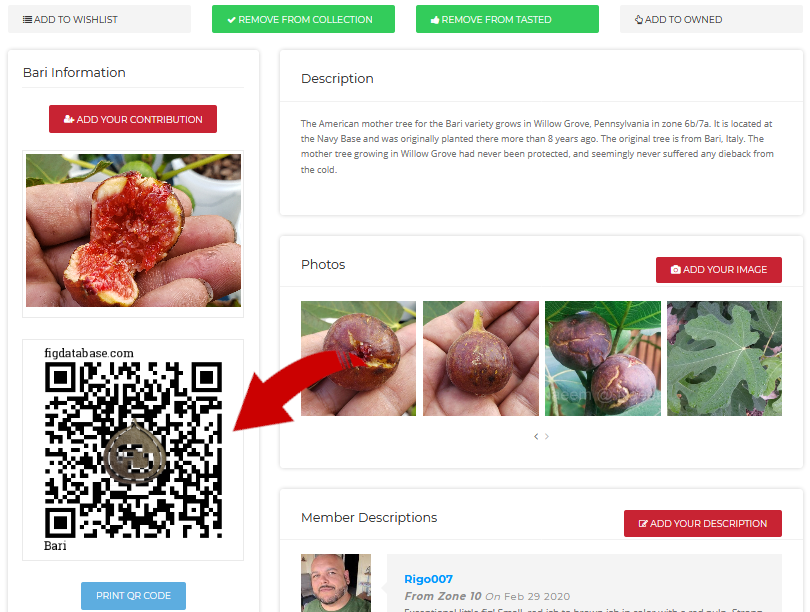
- You can find a few options on your lists on your profile page, under the "My Collection" tab, in the form of a drom-down bar.
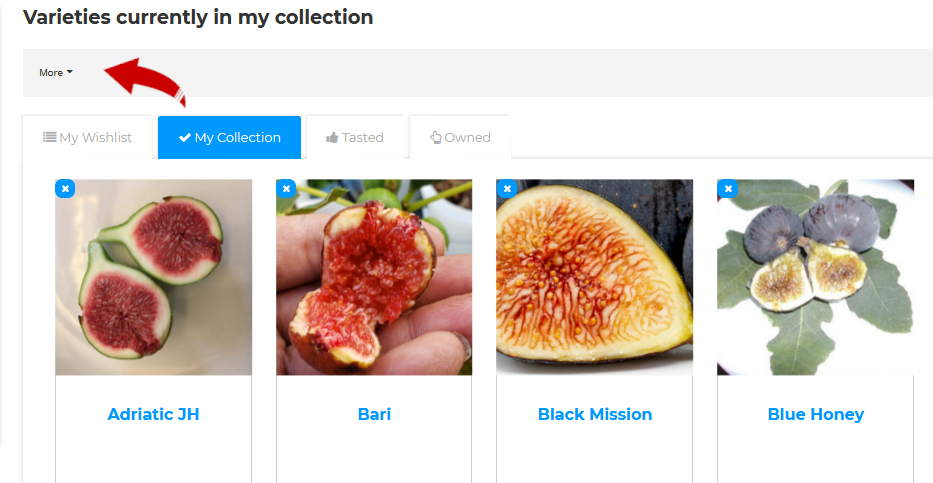
- One option is (Print My Collection) to print out all of your collection (includes variety image, variety name, description and QR code).
- Second option is (Print All QR Codes) to print out your entire collection's QR codes.
- Third option is (Download Collection PDF) to download your entire collection in PDF format.
- Fourth option is (Download Collection List PDF) to download only the names of varieties in your collection (This is handy for when you are trading and need to share with other members what you have in your collection).
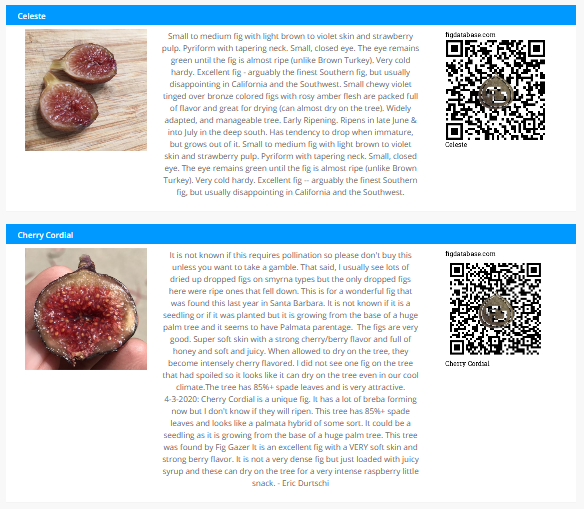

- Fig Variety Abbreviations
If you come across a frequently used abbreviation that is not included in the Fig Database or the list below, please contact me to have it included.
Adriatic JH - JH is Joe H, the finder
BG - Bourjasotte Grise
Bi39 - Beniamino Infelise 1939
BM - Black Madeira, Black Mission
BMkk - Black Madeira from originator kk
BN - Bourjasotte Noir
BT - Brown Turkey
CDDB - Col de Dame Blanc, Col de Dame Bordissotenca
CDDBN - Col de Dame Blanca/Negra
CDDC - Col de Dame Ciutat
CDDG - Col de Dame Gegantina (Gegante), Col de Dame Gris (Grise)
CDDM - Col de Dame Mutante
CDDN - Col de Dame Noir/Negra
CDDR - Col de Dame Rimada, Col de Dame Roja (same as Rossa)
CLBC - Colonel Littmans Black Cross
GB - Genovese Bianco
GdSJ - Gris de St Jean
GN - Genovese Nero, Galicia Negra
GNaf - Genovese Nero from Adriano F
IC - Improved Celeste
LdA - Longue d'Aout
MBVS - Marseilles Black VS. VS is Herman's initials
MIB - Madeira Island Black
NDB - Noire de Bellone, Noire de Barbentane
NDC - Noire de Caromb
PT - Ponte Tresa
RDB - Ronde De Bordeaux
VDB - Violette de Bordeaux
VdS - Violette de Soleils
WM - White Marseilles
WM #1 - White Madeira #1
- Growing Supplies
- Beneficial Nematodes
- ARS Pruners on eBay
- ARS Pruners on Amazon
- Poly bags for fig-pops on Amazon
- Poly bags for fig-pops on eBay
- Felco pruning saw on eBay
- Felco pruning saw on Amazon
- 4' bamboo stakes on eBay
- 4' bamboo stakes on Amazon
- A.M. Leonard Items on eBay
- A.M. Leonard Items on Amazon
- Grafting Tape & Buddy Tape on eBay
- Grafting Tape & Buddy Tape on Amazon
- Grafting Tools on eBay
- Grafting Tools on Amazon
- Corona Products on eBay
- Corona Products on Amazon
- 32 oz Clear PET cups
- 32 oz Clear PETE cups
- Treepots Budding Grafting Large Seedling Pots on eBay
- Drip Irrigation Kits & Accessories on eBay
- Drip Irrigation Kits & Accessories on Amazon
- 4x16" Clear 2Mil Poly Bags Layflat Open Top Plastic Packaging Baggies
- Xtreme Gardening Products (MYKOS)
- Coco Coir on Amazon
- Sphagnum Moss on Amazon
- Coco Coir on eBay
- Sphagnum Moss on eBay
- Hardiness Zone Maps
- Highly Recommended and Reputable Sellers and Businesses
-
eBay (for trees, cuttings and dried figs)
-
Growing Is Life (Merch)
- How big does a fig tree get?
If left alone a fig tree can grow up to 30 feet high and wide. Thankfully, all fig trees can be kept under control by pruning or growing in a pot. There are also some varieties of fig tree that stay compact and dwarfed.
- How do I grow a fig tree?
Growing a fig tree can be a rewarding experience, whether you're aiming for a bountiful harvest or simply enjoying the aesthetic and shade it provides. Here’s a comprehensive guide to help you grow a fig tree successfully:
Choosing the Right Fig Tree:
-
Variety Selection:
-
Climate Compatibility: Select a fig variety that is well-suited to your climate. Common varieties include 'Brown Turkey,' 'Black Mission,' 'Kadota,' and 'Chicago Hardy' (known for its cold hardiness).
-
-
Nursery or Online Purchase:
-
Reputable Source: Buy your fig tree from a reputable nursery or online retailer to ensure you get a healthy plant.
-
Planting Your Fig Tree:
-
Site Selection:
-
Sunlight: Choose a location that receives full sun, at least 6-8 hours of direct sunlight daily.
-
Soil: Ensure the soil is well-drained. Fig trees prefer slightly acidic to neutral pH (6.0-7.0) but can tolerate a range of soil types.
-
Space: Provide ample space for growth. Standard fig trees need about 15-20 feet of spacing, while dwarf varieties can be spaced 10 feet apart.
-
-
Planting Process:
-
Digging the Hole: Dig a hole twice the width and the same depth as the root ball.
-
Amending Soil: Mix the excavated soil with compost or well-rotted manure to improve fertility and drainage.
-
Planting Depth: Place the fig tree in the hole at the same depth it was growing in its container. Spread out the roots gently.
-
Backfilling: Backfill the hole with the amended soil, firming it gently around the roots.
-
Watering: Water thoroughly after planting to settle the soil and eliminate air pockets.
-
Caring for Your Fig Tree:
-
Watering:
-
Consistent Moisture: Keep the soil consistently moist, especially during the first year. Once established, fig trees are relatively drought-tolerant but benefit from regular watering during dry periods.
-
Avoid Overwatering: Ensure the soil does not become waterlogged to prevent root rot.
-
-
Mulching:
-
Mulch Layer: Apply a 2-4 inch layer of mulch (straw, wood chips, or compost) around the base of the tree to retain moisture and suppress weeds. Keep the mulch a few inches away from the trunk to prevent rot.
-
-
Fertilizing:
-
Balanced Fertilizer: Use a balanced, slow-release fertilizer in the spring. Avoid excessive nitrogen, which promotes leaf growth at the expense of fruit production.
-
Organic Options: Compost and well-rotted manure are excellent organic options.
-
-
Pruning:
-
Initial Pruning: Prune the tree when planting to shape it and remove any damaged branches.
-
Annual Pruning: Prune in late winter or early spring before new growth starts. Remove dead, diseased, or crossing branches and shape the tree to maintain an open structure.
-
-
Pest and Disease Management:
-
Monitoring: Regularly inspect the tree for pests such as aphids, scale, and nematodes. Use insecticidal soap or horticultural oil if needed.
-
Disease Prevention: Ensure good air circulation around the tree to prevent fungal diseases. Remove fallen leaves and fruit to reduce disease risk.
-
Harvesting Figs:
-
Ripeness Indicators:
-
Color and Softness: Figs are ripe when they change color and become soft to the touch. They should be easy to pick from the tree.
-
Taste: Ripe figs are sweet and flavorful. Taste is the best indicator of ripeness.
-
-
Harvesting Technique:
-
Gentle Picking: Harvest figs gently to avoid damaging the fruit or the tree. Use scissors or pruning shears if needed.
-
Conclusion:
Growing a fig tree involves selecting the right variety, planting it in a suitable location, and providing consistent care through watering, mulching, fertilizing, and pruning. With proper care, your fig tree will thrive and produce delicious fruit for years to come. Whether you're a novice or an experienced gardener, following these steps will help ensure a successful and rewarding fig-growing experience. There are truly many ways of planting and some to people are better than others. I (Rigo) wrote Grow Your Own: A Beginner's Guide to Rooting Figs for you to have one more option on how to get started growing your own fig tree. It is free to download for everyone.
-
- How long does it take a fig to ripen?
The time it takes for a fig to ripen can vary depending on several factors, including the fig variety, growing conditions, and overall health of the tree. Here’s a detailed breakdown of what to expect:
Factors Influencing Ripening Time:
-
Variety of Fig:
-
Common Varieties: Different fig varieties have different ripening times. For instance, 'Black Mission' and 'Brown Turkey' figs tend to ripen earlier in the season, while 'Kadota' and 'Calimyrna' figs might ripen later.
-
-
Climate and Growing Conditions:
-
Temperature: Figs ripen more quickly in warmer climates with plenty of sunshine. High temperatures and long days promote faster ripening.
-
Watering: Consistent watering helps figs ripen properly. However, overwatering can cause figs to split or develop a watery texture.
-
-
Tree Age and Health:
-
Mature Trees: Older, well-established fig trees generally produce and ripen fruit more reliably than younger trees.
-
Tree Health: A healthy tree with adequate nutrients will support better and faster fruit ripening.
-
Typical Ripening Time:
-
From Fruit Set to Ripening:
-
Timeframe: Once a fig fruit has set (started to form), it typically takes about 60 to 90 days to fully ripen. This period can vary with the factors mentioned above.
-
-
Seasonal Timing:
-
Early Season (Breba Crop): If your fig tree produces a breba crop (first crop on last year’s growth), these figs usually ripen in late spring to early summer.
-
Main Crop: The main crop, which grows on the current season’s growth, generally ripens in late summer to early fall.
-
Signs of Ripeness:
-
Color Change:
-
Varietal Differences: Different fig varieties change color when ripe. For example, 'Black Mission' figs turn a deep purple-black, while 'Kadota' figs become yellowish-green.
-
-
Texture:
-
Softness: Ripe figs become soft to the touch. They should yield slightly when gently pressed but not be mushy.
-
Stem Bend: The stem of a ripe fig often bends and droops slightly.
-
-
Ease of Harvest:
-
Separation: Ripe figs should detach easily from the tree. If you have to pull hard, the fig is likely not fully ripe yet.
-
-
Taste:
-
Flavor: The best indicator is taste. Ripe figs are sweet, rich, and flavorful. Unripe figs are often bland and less juicy.
-
-
- How long will it take my fig tree to fruit?
The time it takes for a fig tree to produce fruit can vary depending on several factors, including the tree's variety, growing conditions, and care. Here's a detailed look at what you can expect:
Factors Influencing Fruiting Time:
-
Tree Age and Variety:
-
Young Trees: Typically, a fig tree planted from a young sapling or cutting will start producing fruit within 2 to 3 years. Some varieties might take a bit longer, up to 4 or 5 years, depending on their growth rate and environmental conditions.
-
Mature Trees: If you plant a more mature tree, such as a tree that's already a few years old, it may produce fruit sooner, potentially within the first year of planting.
-
-
Growing Conditions:
-
Climate: Fig trees thrive in warm climates with plenty of sunlight. Ideal conditions include long, hot summers and mild winters, which can encourage faster fruit production.
-
Soil Quality: Well-drained soil rich in organic matter promotes healthy growth and quicker fruiting. Poor soil conditions can delay fruiting.
-
Watering and Fertilization: Consistent watering and appropriate fertilization help fig trees establish strong root systems and produce fruit sooner. Overwatering or under-fertilizing can hinder growth.
-
-
Planting Method:
-
Rootstock vs. Cuttings: Fig trees grown from cuttings typically establish and bear fruit faster than those grown from seeds. Rootstock grafted trees may also fruit more quickly.
-
-
Pruning and Care:
-
Pruning: Regular pruning helps shape the tree, encourages healthy growth, and can stimulate fruit production. Removing dead or diseased branches ensures the tree's energy is directed towards fruiting.
-
Pests and Diseases: Managing pests and diseases promptly keeps the tree healthy and supports quicker fruiting.
-
Typical Fruiting Timeline:
-
First Year:
-
Establishment: Newly planted fig trees focus on establishing roots and growing foliage. Fruit production in the first year is rare and typically limited to a few small figs, if any.
-
-
Second to Third Year:
-
Initial Fruiting: Many fig trees begin to produce their first significant crop of figs in the second or third year. The quantity may still be modest as the tree continues to grow and establish itself.
-
-
Fourth to Fifth Year:
-
Increased Production: By the fourth or fifth year, a healthy fig tree should start producing more substantial and consistent fruit crops. The tree will be more established and capable of supporting larger yields.
-
-
- How many crops does a fig tree produce?
Fig trees can produce one or two crops of fruit per year, depending on the variety and growing conditions. Here's a detailed look at the types of crops fig trees can produce:
Types of Fig Crops:
-
Breba Crop:
-
Timing: The breba crop is the first crop of the year, typically appearing in late spring to early summer.
-
Growth: These figs grow on the previous year's wood, meaning the fruit develops on branches that grew during the previous season.
-
Varieties: Not all fig varieties produce a breba crop. Common fig varieties that do include 'Black Mission,' 'Brown Turkey,' and 'Adriatic.'
-
-
Main Crop:
-
Timing: The main crop is the second crop, usually maturing in late summer to early fall.
-
Growth: These figs grow on the current year's wood, meaning the fruit develops on new growth from the current season.
-
Varieties: Most fig varieties produce a main crop. Common varieties include 'Kadota,' 'Calimyrna,' and 'Chicago Hardy.'
-
Varietal Differences:
-
Common Figs (Ficus carica): These figs can produce both breba and main crops, depending on the variety. The main crop is usually more abundant and of higher quality than the breba crop.
-
Smyrna Figs: Typically, Smyrna figs produce only one main crop per year. These figs require pollination by the fig wasp.
-
San Pedro Figs: San Pedro figs are unique in that they produce a breba crop without pollination and a main crop that requires pollination.
Factors Influencing Crop Production:
-
Climate: In warmer climates with long growing seasons, fig trees are more likely to produce both breba and main crops. In cooler climates, the breba crop may be minimal or absent, and the main crop might be delayed.
-
Tree Age: Younger trees may take a few years to start producing significant crops. As the tree matures, its yield typically increases.
-
Pruning and Care: Proper pruning and care can influence the number of crops a fig tree produces. Pruning encourages new growth, which is essential for the main crop.
-
- How many feet apart should I space my fig trees?
When planting fig trees, it's essential to provide them with enough space to grow and thrive. Here are some guidelines:
Spacing Between Fig Trees:
-
Standard Fig Trees: For standard fig trees, you should space them about 15 to 20 feet apart. This allows each tree ample room to expand its canopy and ensures that the roots have enough space to grow without competing too much with neighboring trees.
-
Dwarf Fig Trees: If you are planting dwarf varieties, which are smaller and more compact, you can space them closer together. Typically, dwarf fig trees should be spaced about 10 feet apart.
Considerations:
-
Air Circulation: Proper spacing ensures good air circulation, which helps prevent diseases and promotes healthier growth.
-
Sunlight: Fig trees need plenty of sunlight to produce high-quality fruit. Adequate spacing prevents shading and ensures that each tree gets enough light.
-
Ease of Harvest: Sufficient space between trees makes it easier to access them for pruning, harvesting, and other maintenance tasks.
-
- How much should I spend on a fig tree?
The cost of a fig tree can vary widely based on several factors, including the tree's size, variety, and where you purchase it. Here are some considerations to help you determine how much you should spend on a fig tree:
Factors Affecting the Cost:
-
Tree Size:
-
Small Seedlings or Cuttings: These are the most affordable options, typically costing between $10 and $30. They are young and will take a few years to mature and produce fruit.
-
Established Trees: Larger, more mature trees can cost between $30 and $100 or more. These trees are usually 2-3 years old and closer to bearing fruit.
-
-
Variety:
-
Common Varieties: Popular varieties like 'Brown Turkey,' 'Black Mission,' and 'Kadota' are widely available and generally less expensive, often falling within the $20 to $50 range.
-
Rare or Specialty Varieties: Less common or heirloom varieties, such as 'Violette de Bordeaux' or 'Panache Tiger,' can be more expensive, sometimes exceeding $50 to $100 depending on availability and demand.
-
-
Purchase Location:
-
Nurseries and Garden Centers: Buying from local nurseries or garden centers allows you to inspect the tree's health before purchase. Prices here might be slightly higher due to the overhead costs of physical stores, typically ranging from $20 to $60 for common varieties.
-
Online Retailers: Online stores often have a broader selection and competitive prices, though you can't inspect the tree before buying. Prices can range from $15 to $50 for small trees, with shipping costs added.
-
Specialty Growers: Specialty fig growers or boutique nurseries may offer higher-quality or rare varieties, often at a premium price. Prices can range from $30 to over $100, depending on the tree's size and rarity.
-
Additional Costs:
-
Shipping: When purchasing online, factor in the cost of shipping, which can range from $10 to $30 or more, depending on the size and distance.
-
Planting Supplies: You may also need to purchase soil amendments, mulch, fertilizer, and potentially a larger container if growing in a pot, adding an extra $20 to $50 to your initial investment.
-
Winter Protection: In colder climates, consider the cost of materials for winter protection, such as burlap or insulation, which can cost an additional $10 to $30.
Budgeting Tips:
-
Start Small: If you're new to fig growing, starting with a less expensive, smaller tree can be a good way to learn without a significant initial investment.
-
Quality over Quantity: Investing in a healthy, well-established tree from a reputable source can pay off in terms of faster fruit production and overall tree health.
-
Consider Local Options: Buying locally can save on shipping costs and support local businesses. Plus, local nurseries may offer varieties suited to your specific climate.
Remember though that the best practice is to stay away from those claiming to have the largest collection of fig trees or that they have found "new" varieties by fig hunting. Also, if you pay over $150 for a fig tree from online auction sites, you've already been dooped.
-
- Informational Forums & Websites
- The Fig Spot - A new fig forum just recently created for those who wish to try something very user friendly and modern.
- Our Figs- Our passions are figs and their culture. There are thousands of varieties worldwide and many are discussed, traded or available at Our Fig Forum.
- Fig Knowledge
- Seattle Garden & Fruit Adventures
- Fig Recipes
- Galgoni
- Pons
- Best resource on fig sex (well, fig reproduction, fig wasp, the genetics of the persistence gene)
- Growing Fruit
- How to make an easy SIP
- Fig Database (Rigo Amador)
- Mountain Figs
- If you miss the Figs4fun forum. Now you can still search the archived topics
- Is it easy to grow fig trees?
Growing fig trees can be relatively easy, especially if you provide the right conditions and care. Here's an overview of what makes fig trees a manageable and rewarding addition to your garden:
Ideal Conditions:
-
Climate: Fig trees thrive in warm climates with plenty of sunshine. They are well-suited to USDA hardiness zones 7-11. In cooler regions, they can be grown in containers and brought indoors during the winter.
-
Soil: Fig trees prefer well-drained soil with a slightly acidic to neutral pH (around 6.0 to 7.0). They can tolerate various soil types, but good drainage is crucial to prevent root rot.
-
Watering: Figs need consistent watering, especially during the growing season. However, they are relatively drought-tolerant once established. Overwatering should be avoided to prevent root diseases.
-
Sunlight: Fig trees require full sun, at least 6-8 hours of direct sunlight daily. This helps them produce the best fruit.
Planting and Care:
-
Planting: Plant fig trees in the spring or early fall. If planting in the ground, choose a sunny location with good air circulation. If planting in a container, use a large pot with adequate drainage holes.
-
Pruning: Minimal pruning is needed, primarily to maintain shape and remove dead or diseased branches. Pruning should be done in late winter or early spring before new growth starts.
-
Fertilizing: Fig trees do not require heavy fertilization. A balanced, slow-release fertilizer applied in the spring can support growth. Avoid excessive nitrogen, which can promote leaf growth over fruit production.
-
Pests and Diseases: Fig trees are generally hardy and resistant to many pests and diseases. Common issues include fig rust, nematodes, and root knot. Regular monitoring and maintaining good garden hygiene can help manage these problems.
Harvesting:
Figs are typically ready for harvest in late summer to early fall. The fruit should be fully ripe and slightly soft to the touch. Harvesting figs at the right time ensures the best flavor and texture.
-
- Main Flavor Groups
Fig Database is all about simplicity. For this reason, we use mostly the flavor grouping created by Pete R. (AscPete) from OurFigs forum. If you want to see the complete Flavor Group created by Pete, Click here to read his post.
What we use for Flavor Group on Fig Database:
Adriatic Berry - Ranging from lightly sweet to very sweet with berry flavor, yellow or green skin and usually red pulp, with more complex additional flavors developing when fully ripe.
Bordeaux Berry - Sweet, with a berry taste which is rich with a slightly complex additional flavors, when ripe (jammy interior), other wise it has a standard Dark Flavor. Fig flavor can range from none to light.
Honey - Honey sweet, ranging from lightly sweet to very sweet with rich (creamy) and or complex additional flavors. Fig flavor can range from none to light.
Sugar - Sugar sweet, ranging from lightly sweet to very sweet with added flavor from light maple to brown sugar and range from simple to complex additional flavors. Fig flavor can range from none to strong.
Other...
- Manage Your Personal Profile and Fig Collection
The user account section on the Fig Database website offers a range of features designed to enhance your experience and help you manage your interactions and data effectively. Here’s a detailed look at what you can do with your Fig Database account:
Profile Home
This is your main dashboard where you can access various features of your account. It provides a quick overview of your activities and accomplishments.
Inbox
Your inbox is where you receive messages from other members. You can read, respond to, and manage your messages here.
Trash
Deleted messages and notifications are stored here, allowing you to recover them if needed.
Edit Profile
Update your personal information, profile picture, and other details to keep your profile current and engaging for other members.
Followers and Following
View and manage the list of members who follow you and those you follow. This feature helps you stay connected with other fig enthusiasts and keep track of their updates and posts.
My Business Ads
If you have ads or listings for fig-related businesses or products, this section allows you to manage them. You can post new ads, edit existing ones, and track their performance.
Change Password
For security reasons, you can change your account password regularly. This section provides a simple interface for updating your password.
Delete My Account
If you decide to leave the Fig Database, this feature allows you to permanently delete your account and all associated data.
Logout
Safely log out of your account to ensure your information remains secure when you’re not using the site.
Wishlist and Collections
Your account includes features to help you manage your fig varieties:
- My Wishlist: Keep track of fig varieties you are interested in acquiring. This section allows you to add, view, and manage the figs on your wishlist.
- My Collection: Document and manage the fig varieties you currently own. This helps you keep an organized record of your fig trees.
- Tasted: List the fig varieties you have tasted, along with your tasting notes and ratings.
- Owned: Keep a record of the fig varieties you own, which is useful for tracking your collection's growth and diversity.
Accomplishments
Your profile displays your accomplishments, including the number of pictures uploaded, descriptions added, variety details provided, reviews written, and feedback given. This section highlights your contributions to the Fig Database community.
Social Features
Interact with other members through various social features. You can follow other users, receive followers, and engage with their posts and comments. This fosters a sense of community and allows for the exchange of knowledge and experiences.
Malcolm Heath, also known in the community as Shaft in the community created a thread with images explaining many of Fig Database's features in detail. I suggest you go, join and check out his thread for more details.
- Mapping System
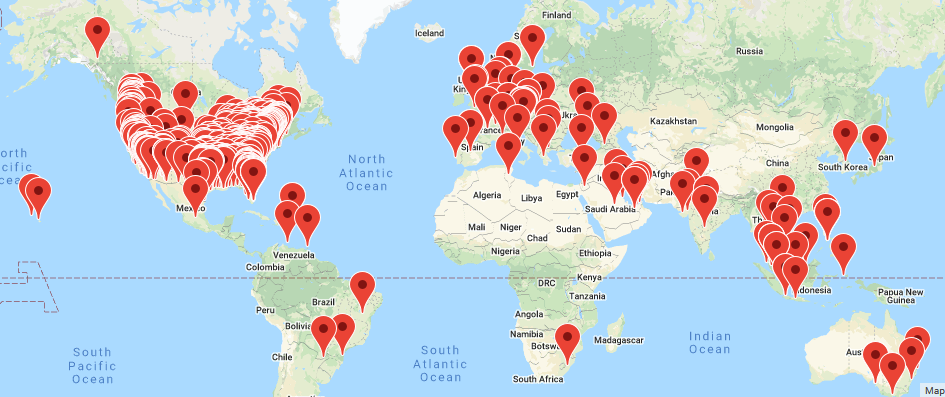
Fig Database's mapping system works in mulple different ways. It uses your zone selected at registration. It is then displayes in the following sections:
- Home page, to show the number of registered members from around the world (displayed on the image above).
- In the variety detail pages, under the tab "Growing Locations" you can see on the map, Fig Database members and location in which a variety is being grown (when you add a variety to your "Collection" list, it displays your username and location in the map.
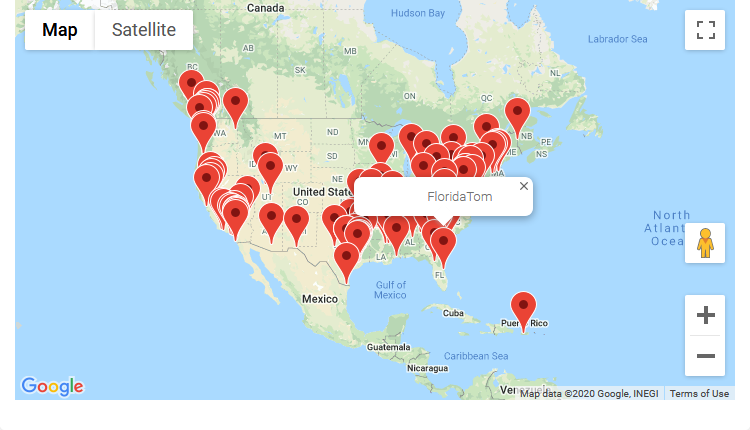
- On a user's profile page, as per location of the user. You can see a Fig Database member's approximate location.
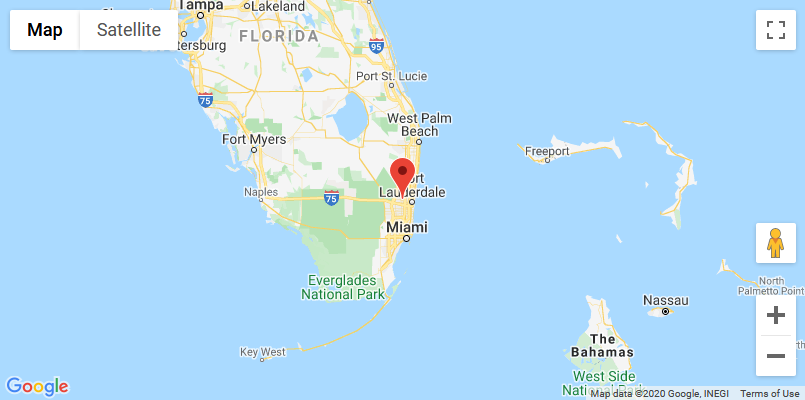
- More Into Your Catalog
This is just another one of Fig Database's special feature. You now have a special catalog so that you can add specific information to any of your fig varieties saved under your "My Collection" list.
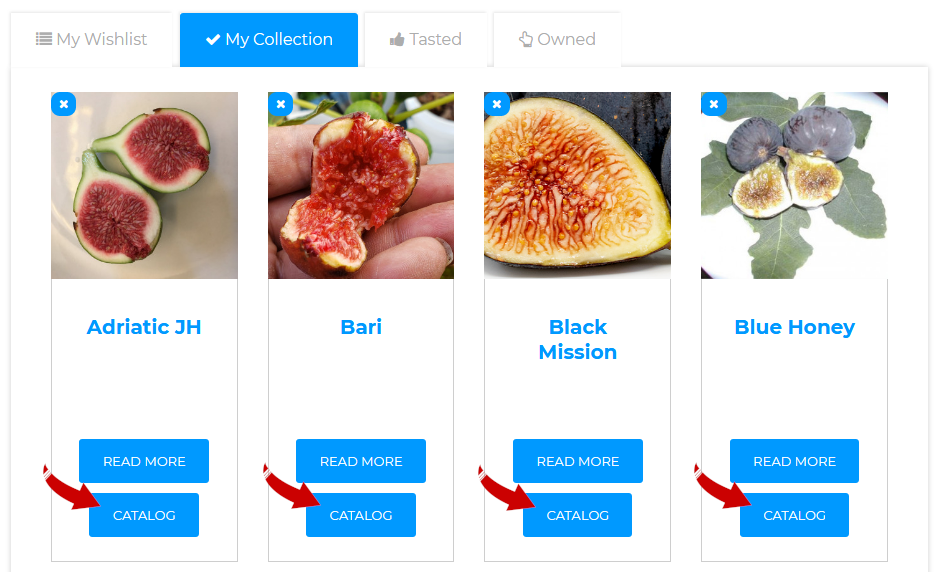
Once you click on the varieties catalog button, it will open the catalog form for you to enter and record all of your information. Many useful fields have been provided to you for good record keeping. Do not forget to click on the UPDATE CATALOG to save your entry.

Notice also that within this form, you have the option to print or share.
- Other Useful Abbreviations and Acronyms
Please have a look at Fig Database's Glossary
- Predefined Fig Variety Searches
These are predefined searches used often by other members of the community. These are not complete and will changed as more information is entered and or added to the database. If you have a search request, please send us a message with your search list or suggestions.
- Recommended Books
- Plant Propagation, By Alan Toogood
- Grow a Little Fruit Tree By Ann Ralph
- Grow Figs Where You Think You Can’t by Steven Biggs
- Fruitipedia - An online fruit encyclopedia
- Under The Fig Tree by Sue Simpson
- Under the Fig Leaf by Sherri P. Lee on Amazon
- The Fig: Its History, Culture and Curing: With Descriptions of the Known Varieties of Figs by USDA
- Fig Heaven: 70 Recipes for the World’s Most Luscious Fruit by Marie Simmons
- Gods, Wasps and Stranglers: The Secret History and Redemptive Future of Fig Trees by Mike Shanahan
- Fig Growing in the South Atlantic and Gulf States by USDA
- Figs: A Global History by David C. Sutton
- A Guide to Growing Figs under Glass by David Thomson
- Fig Culture. Edible Figs: Their Culture and Curing by Gustav Eisen
- Repository Of Fig PDF Files
If you come across a PDF file that is not included in the Fig Database or the list below, please contact me to have it included.
- A Pathogen Of Ficus Carica - Florida
- A review on Ficus palmata (Wild Himalayan Fig)
- Belleclare Nursery Final List You may also be interested in the Ethnic Figs in America by Ray Givan
- Bordissot Negra
- California Agricultural Extentions Service
- Caprifigs and Caprification by Ira J. Condit
- Caracteritzaciode cultivars de figueraa Mallorca
- Caracterizacion de variedades de higuera cultivadas en Extremadura
- Case Study: Estahbanat Rainfed Fig System - Iranian Agricultural Heritage System -
- Cesi Fig (ÇEŞİTLER)
- Champagne Fig
- COLECÇÃO DE FIGUEIRAS DO ALGARVECARACTERIZAÇÃO MORFOLÓGICA DE VARIEDADES
- Comparing the genetics of Black Madeira KK, Figo Preto and Craven’s Craving
- Globally Important Agricultural Heritage Systems (GIAHS)
- Desarrollo del cultivo del higo (Ficus carica) para consumo fresco y procesado, como una alternativa de diversificación para el sector agrícola.
- Directrices Para La Ejecucion Del Examen De La Distincion, La Homeneidad Y La Estabilidad
- Discover Figs by Wallace P.
- Dried Figs
- Ecole Nationale Superieure Agronomique
- El cultivo de la higuera
- Estahbanat Rainfed Fig System-Iranian Agricultural Heritage System
- Fig biology by J. Galil
- Fig Characteristics Useful in the Identification of Varieties by Ira J Condit
- Fig Culture in California by Ira J. Condit
- Fig Demonstration Plot Texas A&M AgriLife Extension Service - Hays County
- Fig Endosepsis: An Old Desease Still A Dilemma For California Growers
- Fig Genotype
- Fig Planting And Growing Tips
- FIGS - Extension Fruit Specialists, Texas AgriLife Extension
- Figs - Study by: Akath Singh, Jai Prakash, P.R. Meghwal and S.A. Ranpise
- Figs - For Commercial and Home Production in Louisiana
- Figs in the Home Planting
- Figs in the Pacific Northwest
- Figs of the World - Campanière Page 1
- Figs of the World - Campanière Page 2
- Figs- University Of Kentucky
- Fig Tree Named Sequoia
- Fruit Spoilage And Diseases Of Figs
- FRUITS AND NUTS - Figs In The Home Planting.pdf
- Grow Your Own A Beginner's Guide to Rooting Figs By Rigo Amador
- Gulf Coast Fruit Study Newsletter
- Gustavus Augustus (Gustav) Eisen (1847-1940)
- HILGARDIA - A Journal of Agricultural Science - Condit, I.J. 1932 The structure and development of flowers in Ficus carica L
- FIG VARIETIES: A MONOGRAPH IRA J. CONDIT
- Home Fruit Production - Figs
- Home Garden Figs - Georgia
- In The San Joaquin Valley - Calimyrna Variety - 2005
- Italian Numbered Figs Found At Bay Area Scion Exchanges
- James Robin Sr.
- Jim Kamas, Monte Nesbitt & Larry Stein Extension Fruit Specialists, Texas AgriLife Extension
- Journal of the American Society for Horticultural Science - Selection of the Most Discriminating Morphological Qualitative Variables for Characterization of Fig Germplasm
- Localizacion De Variedades Locales De Higuera
- Louisiana Figs
- LSU Gold Fig
- LSU Tiger Fig
- Mare de Déu
- O’Rourke, Champagne and Tiger Figs
- O'Rourke Fig
- O'rouoke - Champagne and Tiger Figs
- Overview Of An Ancient Fruit
- Plant Inventory #153 - USAD
- Problems Identifying Fig Varieties
- Problemas Fitosanitarios Asociados el Cultivo de Higuerilla en Colombia
- Proceso De Secado Y Prensado De Higos En Canarias
- Promising New Seedling Fig - Conadria
- Quality and physiology of two cultivars of fresh-cut figs in relation to ripeness, storage temperature and controlled atmosphere
- Sample Costs To Establish A Fig Orchard And Produce
- Quality and physiology of two cultivars
- Screening Diverse Fig Cultivars for Commercial Potential
- Seeds and plants imported during the period from September, 1900, to December, 1903
- Situal actual y perspectivas del cultivo de la higuera en España
- The Core Historical Literature of Agriculture (CHLA)
- The Fig by Ira J. Condit
- The Fig: Botany, Horticulture,and Breeding.pdf
- THE FIG: Its History, Culture, And Curing With A Descriptive CatalogueOf The KNown Varieties Of Figs. By Gustav Eisen
- The Fig: An Overview Of An Ancient Fruit
- The Fig - University Of Florida
- THE FRUIT MANUAL: The Fruits And Fruit Trees Of Great Britain.pdf
- The Gardeners Dictionary (Complete)
- The Gardeners Dictionary (Shortcut)
- The Improvement Of Quality In Figs
- The Incredible Edible Fig Presentation
- The J.C. Forkner fig-gardens recipes; how to serve figs in the home
- The Kadota Fig: A Treatise on its Origin, Planting and Care By W. SAM CLA" K Sulta na, Cal .
- The NAFEX FIG Page
- Third Biennial Report Of The Commissioner Of Horticulture Of The State Of California For 1907-1908
- Tree Training and Managing Complexity and Yield in Fig
- Universidad De Cuenca
- University of Florida
- University of Kentucky
- Variedades De Higuera
- Resources
If you come across information or item/s that is not included in the resource page, please contact me to have it included.
The resource page is where the educational and recommended information is all at! We do the research, you do the easy search, as simple as that! We add all the recommended forums to visit, trusted stores and sites to shop at, trusted ebay sellers, the most used tools and materials used by other fig growers and even books of the highest standards.
- Should I wrap my fig trees in the winter?
Whether or not to wrap your fig trees in the winter depends largely on the climate in which you are growing them. Here are some guidelines to help you decide and understand how to properly protect your fig trees during the colder months:
Considerations for Wrapping Fig Trees:
-
Climate and Hardiness Zone: Fig trees are generally hardy in USDA zones 7-11. If you live in a region where winter temperatures regularly drop below 20°F (-6°C), wrapping your fig trees can help protect them from cold damage.
-
Variety: Some fig varieties, such as 'Chicago Hardy' and 'Brown Turkey,' are more cold-hardy and can withstand lower temperatures. Even these varieties, however, may benefit from winter protection in extremely cold climates.
Benefits of Wrapping:
-
Protection from Frost: Wrapping helps shield the tree from frost and freezing temperatures, which can damage or kill the tree.
-
Wind Protection: It also protects the tree from cold winter winds that can cause desiccation (drying out) of the branches and bark.
-
Rodent Protection: Wrapping can deter rodents and other animals from gnawing on the tree’s bark during winter.
How to Wrap Fig Trees:
-
Prune the Tree: Before wrapping, prune the fig tree to remove any dead, diseased, or crossing branches. This makes wrapping easier and helps the tree conserve energy.
-
Mulch the Base: Apply a thick layer of mulch (straw, leaves, or wood chips) around the base of the tree to insulate the roots and retain moisture.
-
Wrap the Tree:
-
Burlap or Landscape Fabric: Use burlap or landscape fabric to wrap the tree. These materials allow the tree to breathe while providing insulation. Avoid using plastic, as it can trap moisture and cause fungal issues.
-
Wrap Layers: Start at the base of the tree and wrap upwards, overlapping each layer slightly. Secure the wrap with twine or zip ties.
-
Additional Insulation: For extra protection, you can place a layer of straw or leaves between the tree and the wrapping material. Another method is to wrap the tree with an old blanket or quilt first, followed by burlap.
-
-
Cover the Top: If your winters are particularly harsh, consider covering the top of the tree as well. You can use a cardboard box or construct a simple frame covered with burlap to protect the upper branches.
-
Ventilation: On milder winter days, if feasible, temporarily open the wrapping to allow air circulation and prevent moisture buildup.
Unwrapping in Spring:
-
Timing: Once the danger of frost has passed and temperatures begin to rise in the spring, carefully remove the wrapping to allow the tree to resume normal growth.
-
Inspect the Tree: Check for any signs of damage or disease and address any issues promptly.
-
- Tell Everyone About Yourself
You now have the option to write a short "About Me" on your own profile page.
- Using The Advanced Search Function
Created to be used with ease. Just like the basic search function, but with more details to select from. You can be even more specific using the advanced search function. 1) Select the "Advanced Search" button. This will extend the search menu. 2) Select any of the drop down bar options or bullet options available to conduct your search. 3) Click on the "Search" button and it will show you results according to your selected options.
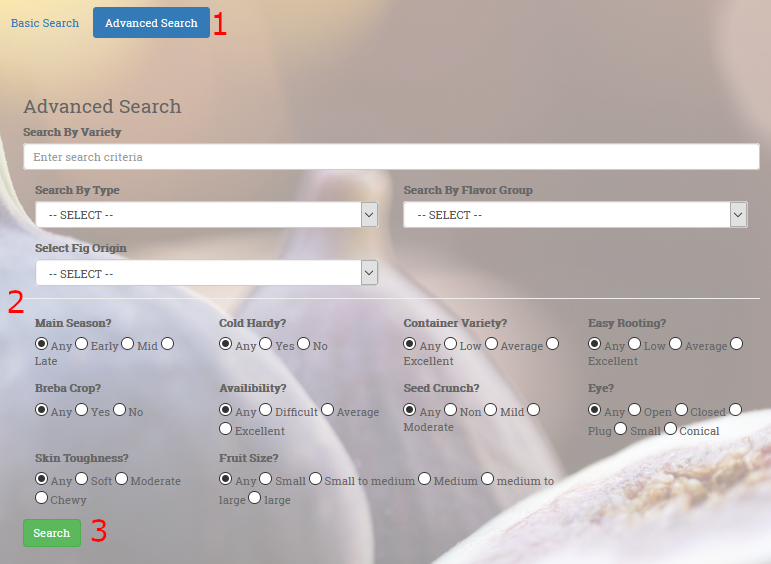
You can also combine your selection of options (e.g. selecting Search By Type: Common, Search By Flavor Group: Honey, Cold Hardy: Yes and clicking will redirect you to all varieties currently fitting those selected options).
- Variety Lists
Variety lists is an idea created by Fig Database to give the users the ability to track their entire collection and information within one place. Do research, add varieties, edit or share from anywhere they are at with the rest of the community. The lists are located (and mostly used thru) in the variety detail pages you visit as pictured below. Once you click on any of these tabs to add them to your list/s (located on your personal profile for management), the selected tabs will turn green, meaning they have been added to your list. The wording on these tabs will then change with the option to "remove from the list". If you click on any of the green tabs, it will then go back to no color, indicating it is not added to your list.

The lists consist of the following:
- Wishlist - You can add varieties to your own wishlist and while visiting a members profile page, look at what's in their wishlist.
- Collection - You can add varieties to your own collection and while visiting a members profile page, look at what's in their collection.
- Tasted - You can add varieties you've tasted before and add them to your list in this category. And as previousely mentioned, while on a members profile page, you can see what varieties they have tasted.
- Owned - You can add to this list varieties you have owned before and for whatever reason, no longer own.
Managing Your Lists
- Location and management of your lists is done thru your profile page. Here, you will be able to see your lists thru tabs, as pictured below.

- My Wishlist - Here is where you find varieties you have added thru the variety detail page by clicking on the "Add to wishlist" button.
- My Collection - Here is where you find varieties you have added thru the variety detail page by clicking on the "Add to collection" button.
- Under this tab, you will notice that each and every variety contains a "Catalog" button as pictured below.
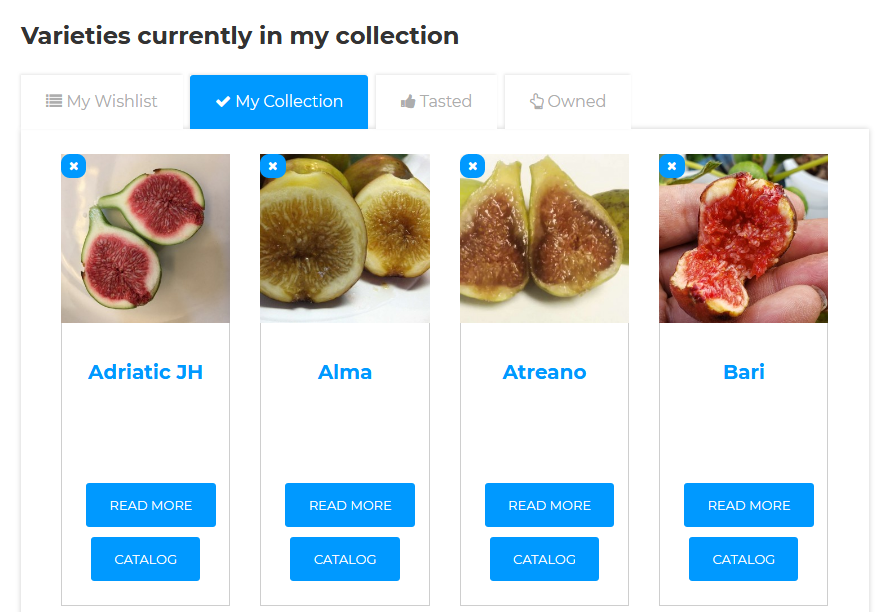
- Inside each catalog, you have a form (pictured below) with pre-made fields you can fill out to keep records and information of your varieties, hence making your collection manageble, organized and having it all in just one place for a quick look-up to read or make changes at any time. You can print or share your catalog at any time.
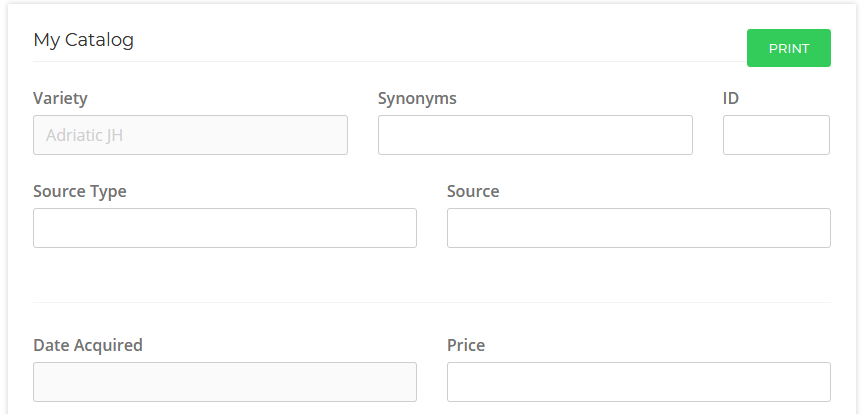
- Tasted - On this tab, you will see varieties you've added from the variety detail page which you have selected to add as varieties you have tasted before.
- Owned - Here are varieties you have added from the variety detail page in which you selected to add because at one point in time, you owned the specified variety.
- Under this tab, you will notice that each and every variety added to this list contains a "Notes" button as pictured below.
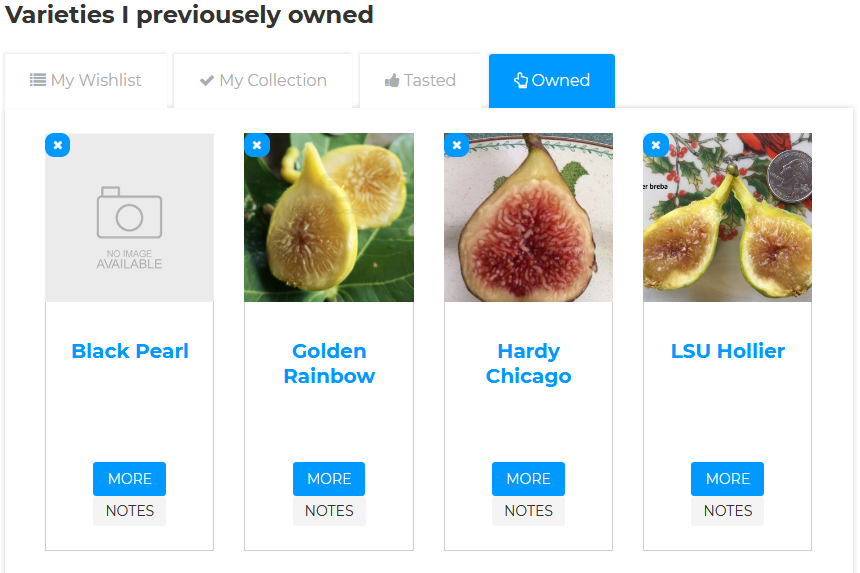
- Notes was added because if you're like me (Rigo), I like to have a note section to write a reason as to why the spific variety is no longer in my collection (why I got rid of it). When you click on the notes button, you will see a simple box to write your notes and then you can save, as pictured below.
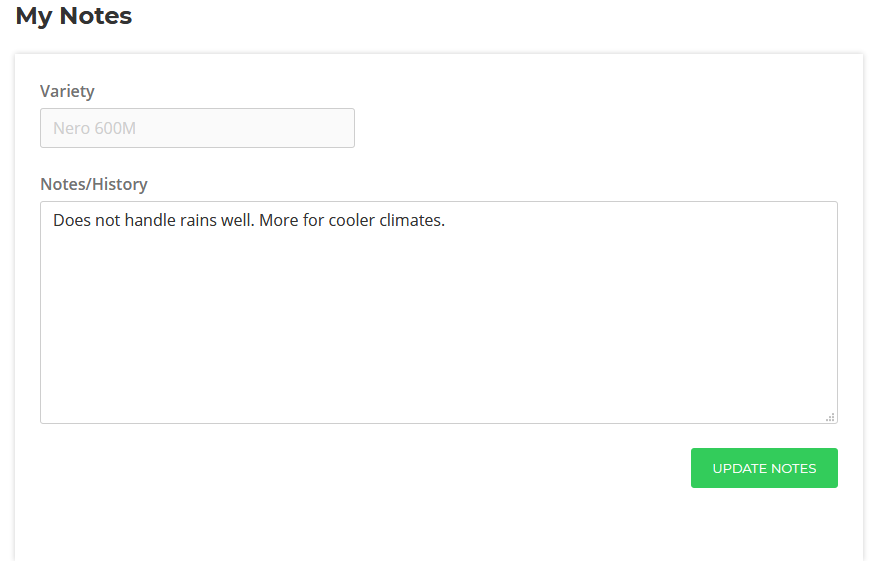
- What are the best varieties of fig trees?
The answer to this question is up to the individual. But, there are some varieties of fig trees that have stood up to the test of time and are easy to acquire. Any of the fig tree varieties listed below do not require pollination, will perform great in a container, and can be easily trained into a tree or bush. If you’re new to fig trees you can’t go wrong with:
-
Strawberry Cypress - This has got to be the most perfect fig variety for those that have lots of rains, heat and humidity. Personally, it is the soldier of figs for South Florida.
-
Celeste - Cold hardy variety for the northeast but one of the best growers in the southeast. It’s great for hot and humid locations because there’s no splitting and a tight eye. Figs are brownish/purple and may vary by location to violet and blue. Light fig flavor and very, very, sweet; like sugar cubes. Very prolific. It’s easy to dwarf this variety in a pot and keep it growing in a tight bush.
-
Hardy Chicago - The name says it all; this variety has been around for decades and longer and is as cold hardy as they come. Good inground to USDA zone 6. Produces figs later in the season in a colder climate. Great mid-season producer in warmer zones. Medium sized brown/purple figs with a strong, sweet berry flavor. Great variety for potted culture. Very easy to propagate.
-
Marseilles Black VS - AKA, MBVS, Marseilles VS. Maybe slightly more cold hardy than Hardy Chicago and might be a good choice inground for USDA zone 5 in a protected location. Otherwise, MBVS is one of the best for potted culture and a reliable producer of figs. Very prolific. Produces medium-sized dark purple to black figs with tiny white spots and bright red pulp. Strong berry flavor.
-
Black Mission - As one of the first domesticated fig varieties introduced to the US, this variety packs a lot of history. Large dark purple figs with smooth skin and red pulp. Produces 2 nice crops of very sweet figs. Great for cooking. This is one of the few figs chosen by commercial growers because of its wonderful qualities. Commercial growers will pick the figs a little too early, though. Let this one hang on the tree to soften and you'll be rewarded with one of the sweetest treats. This variety does great in a pot but will perform better in-ground.
-
Ronde de Bordeaux - AKA, RdB. One of the first fig varieties to put on figs for the season. Ronde de Bordeaux produces 1 crop of dark purple to black, small-sized, round figs with red pulp. Great for eating fresh, making jam, baking, drying, and cooking. Thin skin, jammy texture, light seed crunch, sharp berry flavor that lingers, and very sweet. Extremely prolific. Be prepared for hundreds of figs, even when growing in a pot. Tight eye. Insect and moisture-resistant. Resists splitting even during times of heavy rains. Ronde de Bordeaux is a top-10 variety for potted culture.
-
Violette de Bordeaux - AKA, VdB. This is another fig variety whose history may date back to the 1600’s. At one time it was considered the best-tasting fig in the world. Cold hardy. Produces 2 crops of medium-sized dark purple/black figs with strawberry-colored pulp. 2nd crop is very heavy. The figs are juicy with strong berry flavors and a medium amount of sweetness. VdB has a small eye that resists insects. No splitting.
-
Atreano - Discovered and introduced in the late 1990’s. Atreano produces 2 crops of golden yellow to pale green, medium-sized figs with unique pink to amber-colored pulp that is juicy with a pleasing texture. Strong Honey/Berry flavor with light melon undertones. Very sweet. Thin skin and very easy to bite into. Small eye. Insect and moisture-resistant. Resists splitting even during times of heavy rains. Atreano is another top-10 variety for potted culture. Very prolific.
-
Desert King - If you’re in a cooler climate and can only get one or two fig trees, please consider Desert King. Desert King produces one early crop of large, dark green figs with tiny white spots and strawberry red pulp. The figs are simply sweet and delicious! Great for eating fresh and cooking. Vigorous grower and prolific. Very cold hardy variety.
-
Improved Celeste - Very cold hardy and one of the earliest to produce figs. This is definitely a top-5 pick for container growers and should be on everyone’s cool climate list. Improved Celeste comes from the LSU breeding program. Similar to Celeste in color with a bit of a longer neck. Pink/amber pulp and very, very sweet.
-
Nero 600M - Cold hardy. Fruit ripens perfectly in cooler temperatures. Nero 600M produces 2 crops of black, small to medium-sized high-quality figs with dark red-colored pulp. Very juicy with a pleasing texture. Wonderful fig flavor with hints of berries. Sweet through and through. Small eye. No souring or splitting. Very prolific. This is another reliable fig variety that will give you hundreds of delicious figs every season, even when growing in a pot. Easy to propagate and easily in the top-5 fig varieties for potted culture.
-
Strawberry Verte - AKA, Verte. This variety can’t help but make you smile. Strawberry Verte produces 2 crops of green, medium-sized figs with deep, strawberry-red pulp. The figs are a beautiful contrast of colors. Very jammy, pleasing texture, and a wonderful, rich fig flavor with hints of berries. Sweet through and through. Small eye and a high resistance to insects, souring, and splitting. Not as cold-hardy as some others but does well in-ground in USDA zone 7.
-
Green Ischia - Green Ischia is a vigorous and easy-to-root variety. Prolific and produces bowls of delicious, medium-sized green figs with jammy ruby-red pulp. Green Ischia has a nice fig flavor with deep strawberry undertones and a medium amount of sweetness. Very small eye. Rain and insect tolerant. Produces 2 crops of delicious figs. Great in-ground in USDA Zone 7a/b with winter protection.
-
Smith - Heirloom variety. There’s not enough that can be said about Smith and it should be included in every fig collection. Smith produces one (1) crop of high quality, blushed purple/red with streaks of yellow to light green colored, medium-sized turbinate shaped figs. The deep red-colored and juicy pulp has a pleasing texture and is usually filled with delicious sweet syrup. Very rich and complex flavors with strong berry undertones and an even amount of sweetness. Small to medium-sized eye that oozes a drop of clear honey when the fig is just ripe. Insect resistance and high rain tolerance. Moderate vigor with an average amount of growth every season. Not prone to splitting. Reportedly does well in-ground with no splitting and winter protected in USDA Zone 7b and below.
-
Yellow Long Neck - Yellow Long Neck is a prolific variety that produces 2 crops of large to extra-large, yellow figs with amber pulp. Light sweetness. Light and refreshing flavor with melon undertones. The solid pulp interior looks coarse but has a smooth, juicy texture. Small eye for such a large variety. Very filling; one or two figs are a meal. Very vigorous and prolific. Outgrows a pot very quickly. Great variety for inground.
-
Sal’s Corleone - This is another variety that should be in every fig collection. Sal’s Corleone produces 2 crops of roundish, blush to blood red and dark purple to black medium to large sized high-quality figs. When cut open there is a small cavity in the light strawberry-colored pulp. Very, very juicy with a pleasing texture. Nice fig flavor with hints of berries and a light amount of sweetness. Medium eye. Will develop a ‘star’ pattern split around the eye with too much rain. Split usually will not spoil the fruit and the occurrence decreases with age and will eventually disappear. Sal's Corleone is definitely a top-10 fig variety for potted culture.
-
Col de Dame Gris - AKA, CdDG. If you want to add a fancy variety to your collection at a moderate price, add Col de Dame Gris. Produces one (1) crop of high quality, purple(ish)/grey (heather purple?) colored figs. Small to medium-sized figs with thin, firm skin that does not damage easily. Easy to bite into. Deep red-colored pulp with no cavity. The pulp is dense and jammy with a pleasing texture and small seed crunch. Rich flavor with strong berry undertones and an even amount of sweetness. Very small-sized eye. Insect resistant, resistant to souring, and very rain tolerant. Moderate vigor with an average amount of growth every season.
-
Italian 258 - AKA, I258. One of the Italian numbered figs introduced to the fig-collecting community in the 1980’s. Considered one of the finest figs in the world for taste and looks. Italian 258 has a moderate amount of cold hardiness. Produces medium to large-sized dark purple and green figs. Figs will start to turn slightly bluish as the tree matures. Deep strawberry red, jammy pulp with a wonderful and complex figgy flavor. Strong berry undertones. Very sweet. Very prolific. With a little extra care, cool climate growers will be handsomely rewarded.
-
Violette de Sollies - AKA, VdS. Cold hardy. Violette de Sollies produces 2 crops of dark purple to black large-sized, round(ish) high-quality figs. When cut open the deep strawberry red-colored pulp contains a small cavity that is usually filled with a delicious amount of syrup. The pulp is very juicy with a pleasing texture. Rich flavor with strong non-acidic berry undertones and an even amount of sweetness. Ripens perfectly with a drop of honey appearing at the small eye. Very insect resistant. VdS is a top-10 fig variety for potted culture but will split with heavy rains. Does very well in-ground with no splitting and winter protected in USDA Zone 7.
-
- What does a fresh fig taste like?
A fresh fig offers a unique and delightful taste experience that can be difficult to describe but is often cherished by those who enjoy it. Here's a detailed look at the flavor profile of a fresh fig:
Flavor Profile:
-
Sweetness: Fresh figs are known for their natural sweetness, which is often compared to honey or jam. The sweetness can vary depending on the variety and ripeness of the fig, but it is typically quite pronounced.
-
Richness: Beyond sweetness, figs have a rich, almost syrupy quality. This richness makes them stand out compared to other fruits.
-
Subtle Tartness: Some figs have a hint of tartness or tanginess, which balances the sweetness and adds complexity to the flavor. This subtle tartness is usually more noticeable in less ripe figs.
-
Earthy Undertones: Fresh figs often have a mild, earthy undertone that adds depth to their flavor. This earthiness can be more prominent in certain varieties.
-
Nuttiness: There is a slight nutty flavor present in fresh figs, especially in the seeds. This nutty aspect complements the sweetness and adds a pleasant texture.
Texture:
-
Skin: The skin of a fresh fig is thin and delicate, with a slight chewiness. It is edible and contributes to the overall texture of the fruit.
-
Flesh: The flesh of a fig is soft, luscious, and juicy. It has a slightly grainy texture due to the tiny seeds, which are numerous but unobtrusive.
-
Seeds: The seeds inside a fig are tiny and add a subtle crunch to the otherwise smooth and creamy flesh. They are not hard and are easily chewed.
Aromatics:
Fresh figs have a mild, pleasant aroma that is slightly sweet and fruity. The scent can vary slightly between different fig varieties but is generally inviting and subtle.
Varietal Differences:
Different fig varieties can offer slight variations in flavor and texture. For example:
-
Black Mission Figs: Often very sweet with a rich, jammy flavor.
-
Brown Turkey Figs: Milder in flavor with a balance of sweetness and earthiness.
-
Kadota Figs: Less sweet, with a more delicate flavor and slight nuttiness.
-
Adriatic Figs: Very sweet, often described as having a honey-like flavor with a bit of tartness.
-
- Where can a fig tree grow?
Fig trees (Ficus carica) are quite adaptable and can be grown in a variety of climates and conditions, though they thrive best in certain environments. Here are some key points about where fig trees can grow:
Climate Zones:
-
USDA Hardiness Zones: Fig trees grow best in USDA hardiness zones 7-11. They can tolerate a range of temperatures but prefer warm climates with mild winters. In these zones, they can be grown outdoors year-round.
-
Mediterranean Climates: Fig trees are ideally suited to Mediterranean climates, which are characterized by hot, dry summers and mild, wet winters. This type of climate is found in parts of California, southern Europe, and other similar regions.
-
Subtropical and Tropical Climates: Fig trees can also thrive in subtropical and tropical climates, provided they receive enough sunlight and have well-draining soil.
Growing in Cooler Climates:
-
Container Growing: In regions with colder winters (zones 6 and below), fig trees can be grown in containers. This allows you to move the tree indoors or to a protected area during the winter months to prevent frost damage.
-
Cold Hardy Varieties: Some fig varieties are more cold-hardy and can tolerate cooler temperatures. Examples include 'Chicago Hardy' and 'Brown Turkey,' which can survive in USDA zone 6 with proper winter protection.
Site Selection:
-
Sunlight: Fig trees need full sun to produce the best fruit. They should be planted in a location that receives at least 6-8 hours of direct sunlight daily.
-
Soil: Fig trees prefer well-drained soil with a slightly acidic to neutral pH (6.0-7.0). They can grow in various soil types but require good drainage to prevent root rot.
-
Space: Ensure adequate spacing between fig trees to allow for proper air circulation and growth. Standard fig trees should be spaced 15-20 feet apart, while dwarf varieties can be spaced about 10 feet apart.
Indoor Growing:
-
Containers: Fig trees can be grown indoors in large containers, especially in climates where outdoor growing is not feasible year-round. Choose a pot with good drainage and use a high-quality potting mix.
-
Light: Place the fig tree in a sunny spot indoors, such as near a south-facing window. If natural light is insufficient, consider using grow lights to provide the necessary light for the tree.
-
- Where To Buy Cuttings & Plants?
There are many places to buy but always be aware of who you are buying from. Get to know your seller/s. Below, we give you a list of highly trustworthy sellers to get you started.
-
CalFig - Brian runs CalFig near Fresno, CA and usually has a great selection.
-
Chesapeake Figs - A Maryland registered nursery specializing in Figs, Mulberries, Kiwis, and other fruiting plants.
-
Figaholics - Harvey is a very well known grower in CA
-
FigFair - FigFair is a fig tree nursey located in Oceanside, California. Owned and operated by Michael G. Fons.
-
Forest of Eden - Shaft is becoming a well known seller in the community
-
Tinker Bug Figs - A great fig site run by Christian in NJ
-
Will's Figs - Wills operates a nursery in FL and holds annual sales
-
- YouTube Channels


